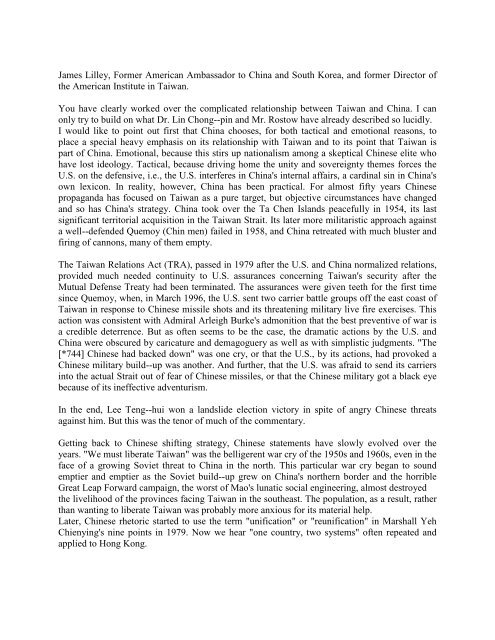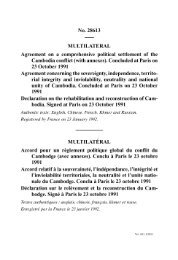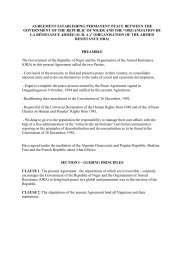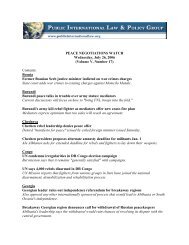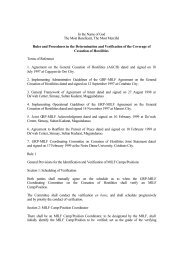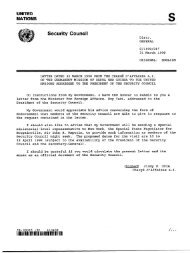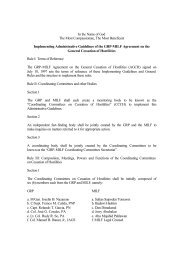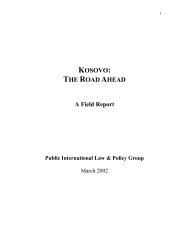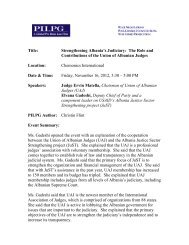The United States, China, and Taiwan - Public International Law ...
The United States, China, and Taiwan - Public International Law ...
The United States, China, and Taiwan - Public International Law ...
Create successful ePaper yourself
Turn your PDF publications into a flip-book with our unique Google optimized e-Paper software.
James Lilley, Former American Ambassador to <strong>China</strong> <strong>and</strong> South Korea, <strong>and</strong> former Director ofthe American Institute in <strong>Taiwan</strong>.You have clearly worked over the complicated relationship between <strong>Taiwan</strong> <strong>and</strong> <strong>China</strong>. I canonly try to build on what Dr. Lin Chong--pin <strong>and</strong> Mr. Rostow have already described so lucidly.I would like to point out first that <strong>China</strong> chooses, for both tactical <strong>and</strong> emotional reasons, toplace a special heavy emphasis on its relationship with <strong>Taiwan</strong> <strong>and</strong> to its point that <strong>Taiwan</strong> ispart of <strong>China</strong>. Emotional, because this stirs up nationalism among a skeptical Chinese elite whohave lost ideology. Tactical, because driving home the unity <strong>and</strong> sovereignty themes forces theU.S. on the defensive, i.e., the U.S. interferes in <strong>China</strong>'s internal affairs, a cardinal sin in <strong>China</strong>'sown lexicon. In reality, however, <strong>China</strong> has been practical. For almost fifty years Chinesepropag<strong>and</strong>a has focused on <strong>Taiwan</strong> as a pure target, but objective circumstances have changed<strong>and</strong> so has <strong>China</strong>'s strategy. <strong>China</strong> took over the Ta Chen Isl<strong>and</strong>s peacefully in 1954, its lastsignificant territorial acquisition in the <strong>Taiwan</strong> Strait. Its later more militaristic approach againsta well--defended Quemoy (Chin men) failed in 1958, <strong>and</strong> <strong>China</strong> retreated with much bluster <strong>and</strong>firing of cannons, many of them empty.<strong>The</strong> <strong>Taiwan</strong> Relations Act (TRA), passed in 1979 after the U.S. <strong>and</strong> <strong>China</strong> normalized relations,provided much needed continuity to U.S. assurances concerning <strong>Taiwan</strong>'s security after theMutual Defense Treaty had been terminated. <strong>The</strong> assurances were given teeth for the first timesince Quemoy, when, in March 1996, the U.S. sent two carrier battle groups off the east coast of<strong>Taiwan</strong> in response to Chinese missile shots <strong>and</strong> its threatening military live fire exercises. Thisaction was consistent with Admiral Arleigh Burke's admonition that the best preventive of war isa credible deterrence. But as often seems to be the case, the dramatic actions by the U.S. <strong>and</strong><strong>China</strong> were obscured by caricature <strong>and</strong> demagoguery as well as with simplistic judgments. "<strong>The</strong>[*744] Chinese had backed down" was one cry, or that the U.S., by its actions, had provoked aChinese military build--up was another. And further, that the U.S. was afraid to send its carriersinto the actual Strait out of fear of Chinese missiles, or that the Chinese military got a black eyebecause of its ineffective adventurism.In the end, Lee Teng--hui won a l<strong>and</strong>slide election victory in spite of angry Chinese threatsagainst him. But this was the tenor of much of the commentary.Getting back to Chinese shifting strategy, Chinese statements have slowly evolved over theyears. "We must liberate <strong>Taiwan</strong>" was the belligerent war cry of the 1950s <strong>and</strong> 1960s, even in theface of a growing Soviet threat to <strong>China</strong> in the north. This particular war cry began to soundemptier <strong>and</strong> emptier as the Soviet build--up grew on <strong>China</strong>'s northern border <strong>and</strong> the horribleGreat Leap Forward campaign, the worst of Mao's lunatic social engineering, almost destroyedthe livelihood of the provinces facing <strong>Taiwan</strong> in the southeast. <strong>The</strong> population, as a result, ratherthan wanting to liberate <strong>Taiwan</strong> was probably more anxious for its material help.Later, Chinese rhetoric started to use the term "unification" or "reunification" in Marshall YehChienying's nine points in 1979. Now we hear "one country, two systems" often repeated <strong>and</strong>applied to Hong Kong.


